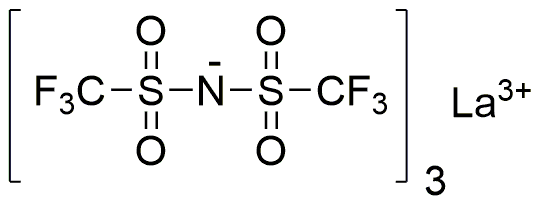Lanthanum(III) bis(trifluoromethanesulfonyl)imide is widely utilized in research focused on:
- Energy Storage: This compound is used in advanced battery technologies, particularly in solid-state batteries, enhancing energy density and stability compared to traditional electrolytes.
- Catalysis: It serves as a catalyst in various chemical reactions, improving reaction rates and selectivity in organic synthesis, making it valuable in pharmaceutical manufacturing.
- Electronics: The material is applied in the production of high-performance capacitors, providing better thermal stability and efficiency in electronic devices.
- Material Science: It is utilized in developing new materials with unique properties, such as improved thermal and chemical resistance, beneficial for aerospace and automotive industries.
- Environmental Applications: The compound is explored for use in waste treatment processes, aiding in the removal of pollutants and heavy metals from industrial effluents.
General Information
Properties
Safety and Regulations
Applications
Lanthanum(III) bis(trifluoromethanesulfonyl)imide is widely utilized in research focused on:
- Energy Storage: This compound is used in advanced battery technologies, particularly in solid-state batteries, enhancing energy density and stability compared to traditional electrolytes.
- Catalysis: It serves as a catalyst in various chemical reactions, improving reaction rates and selectivity in organic synthesis, making it valuable in pharmaceutical manufacturing.
- Electronics: The material is applied in the production of high-performance capacitors, providing better thermal stability and efficiency in electronic devices.
- Material Science: It is utilized in developing new materials with unique properties, such as improved thermal and chemical resistance, beneficial for aerospace and automotive industries.
- Environmental Applications: The compound is explored for use in waste treatment processes, aiding in the removal of pollutants and heavy metals from industrial effluents.
Documents
Safety Data Sheets (SDS)
The SDS provides comprehensive safety information on handling, storage, and disposal of the product.
Product Specification (PS)
The PS provides a comprehensive breakdown of the product’s properties, including chemical composition, physical state, purity, and storage requirements. It also details acceptable quality ranges and the product's intended applications.
Certificates of Analysis (COA)
Search for Certificates of Analysis (COA) by entering the products Lot Number. Lot and Batch Numbers can be found on a product’s label following the words ‘Lot’ or ‘Batch’.
*Catalog Number
*Lot Number
Certificates Of Origin (COO)
This COO confirms the country where the product was manufactured, and also details the materials and components used in it and whether it is derived from natural, synthetic, or other specific sources. This certificate may be required for customs, trade, and regulatory compliance.
*Catalog Number
*Lot Number
Safety Data Sheets (SDS)
The SDS provides comprehensive safety information on handling, storage, and disposal of the product.
DownloadProduct Specification (PS)
The PS provides a comprehensive breakdown of the product’s properties, including chemical composition, physical state, purity, and storage requirements. It also details acceptable quality ranges and the product's intended applications.
DownloadCertificates of Analysis (COA)
Search for Certificates of Analysis (COA) by entering the products Lot Number. Lot and Batch Numbers can be found on a product’s label following the words ‘Lot’ or ‘Batch’.
*Catalog Number
*Lot Number
Certificates Of Origin (COO)
This COO confirms the country where the product was manufactured, and also details the materials and components used in it and whether it is derived from natural, synthetic, or other specific sources. This certificate may be required for customs, trade, and regulatory compliance.

